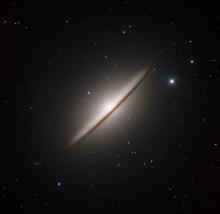Listen to today's episode of StarDate on the web the same day it airs in high-quality streaming audio without any extra ads or announcements. Choose a $8 one-month pass, or listen every day for a year for just $30.
You are here
Quiet Monster
Today, the supermassive black hole in the heart of the Milky Way is quiet. That hasn’t always been the case, though. Several million years ago, it might have shined as a quasar.
The black hole is called Sagittarius A-star. It’s in the center of the Milky Way Galaxy — about 27,000 light-years away. It’s about four million times the mass of the Sun.
We don’t see the black hole itself. But we do see the glow of material around it. As gas and dust spiral into the black hole, they get hot, so they produce energy.
Every few years, the black hole flares up for perhaps a few hours as it ingests something more substantial, such as an asteroid. And about 300 years ago, it flared a million times brighter than normal, perhaps as it gobbled up a star.
There’s evidence of an even bigger eruption six million years ago. The black hole could have shined billions of times its normal brightness as a massive disk formed around it. During that time, it would have been a quasar — one of the brightest objects in the entire universe.
That outburst created a shockwave. It’s still plowing through the galaxy, and should reach Earth in about three million years — reverberations of a quasar.
The black hole is above the spout of the teapot formed by the constellation Sagittarius, which is low in the south at nightfall. Sagittarius A-star is hidden behind thick clouds of dust, so it’s invisible from the eye alone — no matter how brightly it shines.
More tomorrow.
Script by Damond Benningfield






